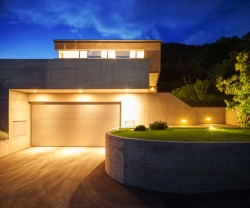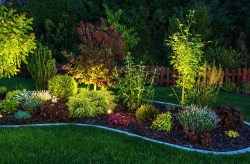If you’re house proud, you’ll have spent a lot of time and money making sure that your home looks at its best during the day. But what about after the sun goes down? Shouldn’t your property look just as fabulous?
 Any good lighting design worth its salt will include different layers of light that provide the three different types of lighting, namely ambient, task and accent lighting.
Any good lighting design worth its salt will include different layers of light that provide the three different types of lighting, namely ambient, task and accent lighting.Melissa Davidson from The Lighting Warehouse says outdoor lighting goes a long way towards improving your home’s night-time curb appeal. She says not only does outdoor lighting extend the amount of time you can enjoy your outdoor living space but it also maximises safety and security as well.
Melissa has these 10 tips for homeowners who are looking to add some outdoor lighting to their home’s exterior.
1. Plan a lighting layout
Walk around your home and identify the areas that you would like to illuminate.
It’s a good idea to use a torch to see how the light will interplay with your home’s architectural and landscaping features. It’s also important to make a note of areas that you would use socially, as well as those dark spots that compromise your safety and security.
2. Install it in layers
Any good lighting design worth its salt will include different layers of light that provide the three different types of lighting, namely ambient, task and accent lighting.
 Plan your pathways using low-voltage, down-facing lights to provide a nicely lit pathway, without glare, to guide you and guests along paths.
Plan your pathways using low-voltage, down-facing lights to provide a nicely lit pathway, without glare, to guide you and guests along paths.As its name implies, ambient lighting provides general overall lighting, and sets the mood or ambience of the space being lit.
Task lighting is designed for globes. Those spaces where work needs to be done, as such, it needs to be bright enough so that you can see what you are doing.
Accent lighting is decorative, and serves to highlight various features and interplay with the ambient lighting to reinforce a particular style.
3. Choose energy efficient options
Spending a little extra from the onset by investing in energy-saving globes will end up saving you a lot of money in the long run, both on your lighting bills, as well as the cost of replacing the bulbs themselves.
Choosing LED globes, for example, can provide energy savings of up to 90% when compared to incandescent globes. They also have a long lifespan of between 20 000 and 30 000 hours, which works out to about 10 years of average nightly use.
4. Stay in control
 Use spotlights to emphasise trees and other large features on your property.
Use spotlights to emphasise trees and other large features on your property.Why not consider motion-activated sensors, day/night-activated sensors, and time switches. This all aids with saving on your lighting bill.
5. Consider your neighbours
Be considerate and make sure that your lighting design does not encroach onto your neighbour’s property.
If this has ever happened to you, then you understand just how annoying it is to have your neighbour’s outdoor lights shining directly into your living space.
So, when planning your design, for those installations that are close to your neighbouring property, select light that shines downwards or position the lights so that they shine solely onto your property.
6. Choose weather-resistant fixtures
For optimum longevity, make sure that the fittings you choose are weather-resistant. Outdoor fixtures should be non-corrosive and UV-resistant.
7. Consider proportion
 Too much light can create light pollution and distract guests and neighbors. Rather aim for a subtle, well-planned landscape lighting scene that accentuates your landscaping, features and home.
Too much light can create light pollution and distract guests and neighbors. Rather aim for a subtle, well-planned landscape lighting scene that accentuates your landscaping, features and home.The ideal size of an outdoor light fitting needs to strike a balance between proportion and size. For example, a single light fitting for the front entrance should measure one-third of the front door’s height. This will balance out the proportions and provide visual interest.
However, if there are two lights at the entrance, for example, each light should measure only one-quarter the size of the front door.
8. Don’t overdo it
Too much light can create light pollution and distract guests and neighbours. Rather aim for a subtle, well-planned landscape lighting scene that accentuates your landscaping, features and home.
For example, plan your pathways using low-voltage, down-facing lights to provide a nicely lit pathway, without glare, to guide you and guests along paths. Or, use spotlights to emphasise trees and other large features on your property. You can use these to wash your garden walls with light creating a dramatic light-and-shadow effect.
9. Safety first
It’s essential to remember that by law, all outdoor lighting needs to be fully sealed against the elements to protect it from rain, irrigation and splashes.
Water and electricity can be a lethal combination, so it’s imperative that a professional electrician installs your light fittings, which should be IP-rated for outdoor use.
IP ratings are expressed as ‘IP’ followed by two numbers that define the degree of protection they offer. The first digit (Foreign Bodies Protection i.e. ‘dirt’) shows the extent to which the equipment is protected against particles (i.e. ‘grime’).
The second digit (Water Protection) indicates the extent of protection against water entering the fixture. Outdoor light fittings should have a minimum IP rating of at least IP44.








